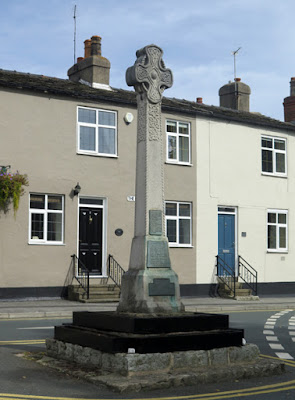My first outing to take advantage of the Heritage Open Days festival in 2019, to Barnburgh, was very productive. In addition to a good exploration of the church and village, the discovery of yellow dolomitic limestone added to my knowledge of Yorkshire’s geology and building stones.
 |
| From Treeton to Barwick-in-Elmet |
The following day, having taken the train to Leeds several times earlier in the year, to prepare a field trip for the Sheffield U3A Geology Group and to visit the church of St. John the Baptist in Adel, I decided to visit All Saints’ church in Barwick-in-Elmet, which is approximately 10 km east of the city centre.
 |
| An early lunch at Khao Gaeng Thai |
After setting off early from Treeton, I arrived in Leeds with plenty of time to get a very early lunch at Khao Gaeng Thai before catching the Conexxions No.64 bus, which takes less than 25 minutes. As I will recount in a later post, this proved to be a very good decision.
 |
| A geological map of the area around Barwick-in-Elmet |
Alighting at the south end of Main Street, with the village being set on the edge of the Magnesian Limestone escarpment, I expected to find most of the historic buildings constructed in local dolomitic limestone but, instead, I discovered that very many are rendered, with some built in Carboniferous sandstone and others with brick.
 |
| Vernacular architecture on Main Street |
There are only a handful of listed buildings in the centre of village, including the Grade II* church, and this includes the war memorial – which is built on the base of an old village cross – Lime Trees Farmhouse and Elmwood House, but I was unable to see the Old Rectory. Even though most of the historic buildings are simple vernacular structures, they add great character to this attractive village, which has an extensive Conservation Area.
 |
| A view of the maypole and the Gascoigne Arms from Elmwood Lane |
There is Britain’s second tallest maypole at the end of Main Street, where I then turned up Elmwood Lane to find the entrance to Hall Tower Hill, a Norman motte and bailey castle that was built at the southern end of a much larger Iron Age hillfort.
 |
| Hall Tower Hill |
Without having yet arrived at the church, I had already encountered very many points of architectural and historic interest and, when stopping to take a few photographs of the Methodist Church, dated 1900, I have subsequently wondered why it is not listed.
Built in what looks to be a local Carboniferous sandstone, with dolomitic limestone dressings, in my experience its offset turret/steeple is a very unusual feature and I am very surprised that it is not mentioned in my copy of Pevsner's guide to the West Riding of Yorkshire.
I then carried on along The Boyle, to try and find the hillfort and, although I found the occasional very overgrown embankment and ditch, I quickly made my way back towards the church along Potterton Lane, where the older houses are built in limestone with red pantile roofs, with later Victorian terraced houses being built in sandstone with Welsh slate roofs.
 |
| An overgrown embankment and ditch at Wendel Hill |
I then carried on along The Boyle, to try and find the hillfort and, although I found the occasional very overgrown embankment and ditch, I quickly made my way back towards the church along Potterton Lane, where the older houses are built in limestone with red pantile roofs, with later Victorian terraced houses being built in sandstone with Welsh slate roofs.
 |
| Vernacular architecture on Potterton Lane |


No comments:
Post a Comment